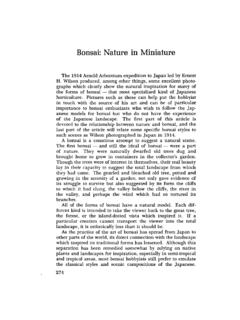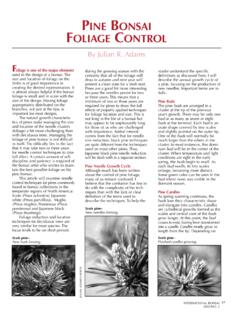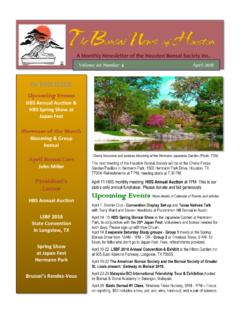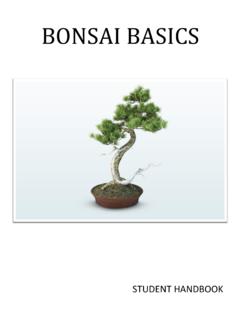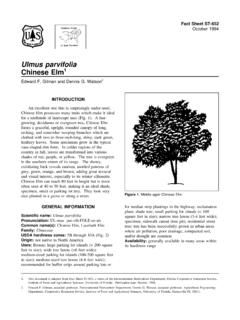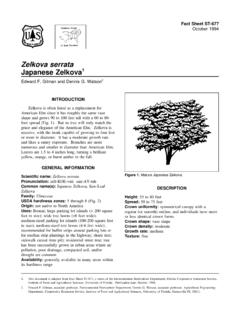Transcription of An Informal History of Bonsai
1 261An Informal Historyo f BonsaiOne of the few positive aspects of human warfare is the in-evitable blending of cultures which takes place immediately uponthe cessation of hostile activities. For a short but crucial periodthe victor is exposed to the best and worst of the former enemy,and vice-versa. In the wake of World War II American societyhas responded with elan to this exposure and to the widestpossible variety of things Japanese. Typical of this has beenthe popularity of the shibui object, understated elegance inhome design, house furnishings, and gardens, and a renewedinterest in oriental arts and after the close of hostilities in 1945 a flood ofoccupation forces, and, a bit later, trade representatives, beganshort tours of duty in Japan. In the ten years between 1945and 1955, hundreds of thousands of Americans spent time inJapan. Persons from every walk of American society enjoyedthis cross-cultural experience, one which formerly had beenconfined to diplomats, businessmen and the affluent.
2 (In facteven through the war years Japan and the Japanese remaineda sort of abstraction to the bulk of the American population.)Among those multitudinous aspects of Japanese culture whichremained in mind was the feeling conveyed to the westernersby those small, carefully trained but artless and natural ap-pearing trees contained by glazed or unglazed pottery contain-ers - the , who will celebrate the 200th anniversary of theircountry s founding in 1976, were faced with the living culturalartifacts of a nation which, although like the Americans inhaving been the result of wave after wave of migrations, hadnearly 2,000 years of in situ cultural History . Indeed some ofthe Bonsai were twice as old as the American nation! Littlewonder that popular authors referred to the "mysterious" culturetechniques, since Bonsai were another facet of the "inscrutable"262orient! In addition to age which never fails to intrigue Ameri-cans, the living trees, many of which only simulate age, alsoconvey other admirable qualities which would entrance lesnouveaux venus of every age - endurance, natural beauty andunderstated many treasures were destroyed during the war, andmany living gardens and Bonsai were lost for lack of care andwatering, one can only wonder at the large number of very oldtrees which survived.
3 And, unlike other works of art, livingtreasures required great care after substantial initial the importation of living plants involves permit proceduresof some complexity very few Bonsai came to the United Statesin the postwar years. However, the small trees are such anubiquitous part of Japanese life that it is safe to say that tensof thousands say, enjoyed, and cherished the idea of were several day-to-day indications that Bonsai hadcaptured the American imagination. Christmas cards printedin Japan for Americans featured a dwarf tree motif. In themid-1950 s American florist and gift shops blossomed withnon-living dwarf trees concocted from driftwood or weatheredbranches topped with a flattened gray lichen to simulate species of Filago, a flat perennial herb of the Composite fam-ily, was imported from India at this time for similar use. These"ming" trees were American equivalents of similarly artificialtrees popular among the Chinese for household decor oftenfashioned from carved semi-precious stones.
4 One of the earliestpopular articles entitled "How to Make a Tree" [living~ appearedin the March 1950 issue of American Homes Magazine. A floodof publications to follow in the 1960 s would demythologize theart for the American public. The strong economic bonds be-tween the United States and Japan has allowed the initial cul-tural flow to continue through the 1970 s. As more Americanswere able to visit Japan and Bonsai materials began to be ex-ported local groups were formed particularly in Californiawhere many Americans of Japanese ancestry were leaders in thefoundation of the California Bonsai Society in 1950. Later anational organization, the American Bonsai Society, with nu-merous affiliates, was organized in we look at the early movement of Bonsai in the Westor at the earliest examples from China perhaps we should con-sider the development of the art in Japan, the country with theearliest leading exponents in modern times, the coiners of theterm itself (derived from the Chinese word p en tsai), and the"Stories of Ladies" by Chin Ying (Ming Period 1368-1644) Top: Terracescene with screen, lacquer table, small potted tree.]
5 Bottom: Garden withpotted plants and small trees. An aptly named era (Ming means bright),it was an era of native rule first in Nanhing then in Peking. Fogg ArtMuseum, Oriental Dept., Harvard which has the largest current number of practitioners.(An early use of the word Bonsai appears in the Seiwanmyoen-Zushi published in Osaka in 1875.) For, as we shall see, whilemany styles of training trees and schools of culture have de-veloped into cults in Japan, and while the culturing of the treesthere is centuries old, there is evidence that the art was flourish-ing in China before the Sung Period (960-1279).The introduction of Buddhism to Japan about 550 is veryimportant in considering the History of Bonsai for it was in thecenturies immediately after that the cultural flowering of Chinaduring the T ang period (618-906) flowed to Japan. ZenBuddhism was to become a popular religion and forever afterto touch the weft of Japanese life.
6 With Zen comes the perfec-tion of the miniature and the associated ideals of self disciplineand the emulation of Nature. Potted trees kept small couldserve as objects of contemplation as well as decoration. Withinthe temples small landscapes and gardens were used symboli-cally to represent Horai-san, the sacred Taoist mountain ofeternal youth. Trees and shrubs in the ground were pruned fornatural effects so that via miniaturization a natural contem-plative scene could be achieved. P en tsai may have originatedfrom transferring small trees from small landscape dramasand/or by artful pruning of larger potted trees used as reliefagainst the traditional oval, rectangular and square motifs ofcourts, furniture and most man-made construction. Strong cul-tural exchanges between Japan and China began early - duringthe Fujiwara Era (794-1192). Earlier the Japanese had beenawed by the wealth and sophistication of the Chinese customs and religion of China were adopted in part by theruling classes of early Japanese art works still extant which showdwarf trees is the scroll Tsurezure Gusa by Kenko Yoshida(1283-1351) and the fifth part of the twenty-scroll KasugaGongen Kenki by Takakone Takashima executed in 1309.
7 Muchlater, in 1890, Tomioka Tessai (1837-1924) painting in a stylereminiscent of earlier Chinese artists of the T ang Period (618-906) produced a scroll depicting two trees in the natural the Japanese literary realm the earliest reference to bonsaioccurs in a document dating to 1095 in which the cultivationof Bonsai is related as an elegant activity for the samurai. Thus,only four hundred years after Buddhism was made a part of thestate religion (in 685), the technique of Bonsai cultivationreceived official approbation for the ruling class. In his collec-tion of essays entitled Tsurczure Gusa, Kenko Yoshida criticizedUnsigned work from the Sung Period (960-1279). Pinus sp., p en tsai ongarden table. The Sung was a time characterized by a rise in commercial-ism and education. The Sung artists depicted the nouveau riche of theirtime. From The Pageant of Chinese Painting. Otsuke Kogeisha, Tokyo, bad taste of enjoying deformed trees and disproves that thisform was preferred by those of his time.
8 In the Noh dramaHachi-no-ki of the Muromachi Period (1334-1573) the authorZeami (1363-1443) develops a story about the fifth ruler of theKamakura government who, wandering as a monk, is welcomedto the humble house of a discredited samurai. The latter iswilling to sacrifice a cherished Bonsai to warm the visitor. Asa consequence the official is restored, and three flowering trees,266 Ithe apricot, cherry and pine, are established as Bonsai favorites- as these were made as gifts from the ruler to the filial is also the legend of Hikozaemon Okubo, an elder states-man, in the government of the third Tokugawa Shogun, Iemitsu(1623-51), who threw down his most cherished Bonsai whileadmonishing his ruler. In modern times post-World War IIPrime Ministers have been Bonsai enthusiasts following the leadof Count Okubo of the 17th century and Kujoji Itoh of the late19th from the Edo Period (1615-1868) testify to thevogue of potted trees, and of such a kind as to rival the tulipo-mania of the 17th century Europe or the pteridomania of Vic-torian times.
9 According to the knowledgeable Chuzo Onukiprices for potted trees went beyond bounds: "As an example,according to a publication of this period named Koshienyawa,certain trees were bought and sold at exhorbitant rates accordingto the number of buds growing on them."Variegated forms of plants requiring potted culture becamevery popular at this time and aided the focus on the use of potsfor trees and the late 19th century the Meiji Restoration marked thebeginnings of modern Japan. The country was opened to worldtrade and industrialization. Urban centers were born. Also atthis time the influence of the literati painters, an aestheticmovement in the arts which interpreted nature in terms ofhuman values and which was influenced by earlier Chinese art,was being felt. Small potted trees were natural objects for theexpression of the Nanga forms and tastes. Although this schoolwas centered in Kyoto and Osaka, the traditional cultural capi-tals of Japan, by the time of the turn of the century, membersof the new political and cultural class centered in Tokyo werevying with each other in garden-making and Bonsai culture.
10 (This forms a parallel with the rivalries among the nouveauriche of New York society at about the same time.)The early 20th century saw the formation of Bonsai promo-tion groups with publications, auctions and exchanges. InOctober, 1927, Bonsai from the Imperial Household Collectionwere exhibited at the public ceremonies held to honor theaccession of Emperor Hirohito. This symbolic act reinforcedin the public s mind the beauty and desirability of Bonsai justas the Emperor Meiji s encouragement of the art had fueledthe fad in an earlier one of the best sources for the verification of craftor custom is the record of the early travellers. In the case of the267 Orient, which was truly opened to the West only during the 19thand 20th centuries, these records are a staple of those curious and delightful accounts of Japan pub-lished early in this century, the daily record kept by MarieStopes is one to read.
